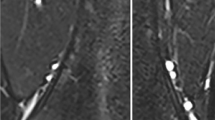Abstract
Background
In our experience, diffusion-weighted imaging with body background suppression (DWIBS) is hard to interpret in children who commonly have foci of restricted diffusion in their skeletons unrelated to pathology, sometimes in an asymmetrical pattern. This raises serious concern about the accuracy of DWIBS in cancer staging in children.
Objective
To describe the signal distribution at DWIBS in the normal developing lumbar spine and pelvic skeleton.
Materials and methods
Forty-two healthy children underwent an MR DWIBS sequence of the abdomen and pelvis. An axial short-tau inversion-recovery (STIR) echo-planar imaging (EPI) pulse sequence was used. Two radiologists did a primary review of the images and based on these preliminary observations, separate scoring systems for the lumbar spine, pelvis and proximal femoral epiphyses/femoral heads were devised. Visual evaluation of the images was then performed by the two radiologists in consensus. The scoring was repeated separately 2 months later by a third radiologist. Restricted diffusion was defined as areas of high signal compared to the background. Coronal maximum intensity projection (MIP) reformats were used to assess the vertebral bodies. For the pelvis, the extension of high signal for each bone was given a score of 0 to 4. Cohen’s Kappa interobserver agreement coefficients of signal distribution and asymmetry were calculated.
Results
All children had areas of high signal, both within the lumbar vertebral bodies and within the pelvic skeleton. Three patterns of signal distribution were seen in the lumbar spine, but no specific pattern was seen in the pelvis. There was a tendency toward a reduction of relative area of high signal within each bone with age, but also a widespread interindividual variation.
Conclusion
Restricted diffusion is a normal finding in the pelvic skeleton and lumbar spine in children with an asymmetrical distribution seen in 48% of normal children in this study. DWIBS should be used with caution for cancer staging in children as this could lead to high numbers of false positive findings or even unjustified upstaging.





Similar content being viewed by others
References
Takahara T, Imai Y, Yamashita T et al (2004) Diffusion weighted whole body imaging with background body signal suppression (DWIBS): technical improvement using free breathing, STIR and high resolution 3D display. Radiat Med 22:275–282
Kwee TC, Takahara T, Ochiai R et al (2008) Diffusion-weighted whole-body imaging with background body signal suppression (DWIBS): features and potential applications in oncology. Eur Radiol 18:1937–1952
Ballon D, Watts R, Dyke JP et al (2004) Imaging therapeutic response in human bone marrow using rapid whole-body MRI. Magn Reson Med 52:1234–1238
Raya JG, Dietrich O, Reiser MF et al (2005) Techniques for diffusion-weighted imaging of bone marrow. Eur J Radiol 55:64–73
Koh DM, Collins DJ (2007) Diffusion-weighted MRI in the body: applications and challenges in oncology. AJR 188:1622–1635
Thoeny HC, De Keyser F (2007) Extracranial applications of diffusion-weighted magnetic resonance imaging. Eur Radiol 17:1385–1393
Li C, Liu ZS, Du XM et al (2009) Clinical value of whole-body magnetic resonance diffusion weighted imaging on detection of malignant metastases. Chin Med Sci J 24:112–116
Takenaka D, Ohno Y, Matsumoto K et al (2009) Detection of bone metastases in non-small cell lung cancer patients: comparison of whole-body diffusion-weighted imaging (DWI), whole-body MR imaging without and with DWI, whole-body FDG-PET/CT, and bone scintigraphy. J Magn Reson Imaging 30:298–308
Muller MF, Prasad P, Siewert B et al (1994) Abdominal diffusion mapping with use of a whole-body echo-planar system. Radiology 190:475–478
MacKenzie JD, Gonzalez L, Hernandez A et al (2007) Diffusion-weighted and diffusion tensor imaging for pediatric musculoskeletal disorders. Pediatr Radiol 37:781–788
Glaser C (2005) New techniques for cartilage imaging: T2 relaxation time and diffusion-weighted MR imaging. Radiol Clin North Am 43:641–653, vii
Ricci C, Cova M, Kang YS et al (1990) Normal age-related patterns of cellular and fatty bone marrow distribution in the axial skeleton: MR imaging study. Radiology 177:83–88
Sebag GH, Dubois J, Tabet M et al (1993) Pediatric spinal bone marrow: assessment of normal age-related changes in the MRI appearance. Pediatr Radiol 23:515–518
Bruegel M, Rummeny EJ (2009) Hepatic metastases: use of diffusion-weighted echo-planar imaging. Abdom Imaging 35:454–461
Padhani AR, Liu G, Koh DM et al (2009) Diffusion-weighted magnetic resonance imaging as a cancer biomarker: consensus and recommendations. Neoplasia 11:102–125
Acknowledgements
We would like to thank Dr. Thorsten Koehler, MD, University Hospital North Norway, Tromsø, for contributing to the data analysis.
Author information
Authors and Affiliations
Corresponding author
Rights and permissions
About this article
Cite this article
Ording Müller, LS., Avenarius, D. & Olsen, Ø.E. High signal in bone marrow at diffusion-weighted imaging with body background suppression (DWIBS) in healthy children. Pediatr Radiol 41, 221–226 (2011). https://doi.org/10.1007/s00247-010-1774-8
Received:
Revised:
Accepted:
Published:
Issue Date:
DOI: https://doi.org/10.1007/s00247-010-1774-8




